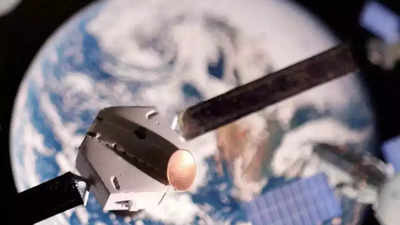- News
- Science News
- Is the universe singing? NASA satellites detect chirping sounds 100,000 km from Earth
Is the universe singing? NASA satellites detect chirping sounds 100,000 km from Earth
NASA's Magnetospheric Multiscale satellites have observed bird-like chorus waves in the Earth's mid-tail neutral sheet, challenging previous knowledge that these waves only form near the dipolar magnetic field. This discovery sheds light on wave-particle interactions, potentially explaining energy transfer in space and phenomena like auroras and planetary radiation belt changes.
Electromagnetic waves are the beautiful system of nature's communication system, with whistler-mode chorus waves being one of the most alluring types. The reason behind their name is that, when converted into audio, these waves sound like chirping birds and are found to be occurring in various planetary environments, such as Earth, Mars, Jupiter, and Saturn.
A new study by NASA's Magnetospheric Multiscale satellites has an important fresh light on these waves. The authors of the research in Nature reported the observation of rising-tone chorus waves in a previously unexplored region: the terrestrial mid-tail neutral sheet, 100,000 kilometers from Earth. This has a peculiar magnetic configuration quite different from the dipolar magnetic field thought to be essential for the generation of these waves.
NASA detects bird-like chorus waves in non-dipolar magnetic regions
Historically, chorus waves were only observed near Earth, where the dipolar magnetic field of the planet dominates the generation and propagation of the waves. This work questions such knowledge, since MMS has observed chorus waves in a region where the magnetic field is considerably more stretched and does not have the shape of a dipole. The region is the mid-tail neutral sheet, located at about 26 Earth radii from Earth.
How are chorus waves formed?
The researchers showed that chorus waves originated from local anisotropic electrons, which describe electrons with different distributions in different directions. High-resolution data of observations revealed "electron holes" in the wave phase space, which are signs of nonlinear interactions between the waves and the particles. Such electron holes describe a process by which energy is transferred from local thermal electrons-another feature predicted earlier. Such waves propagate in a manner consistent with expectations for whistler waves, which include right-hand polarization and parallel orientation to the magnetic field.
New insights into wave-particle interactions and chorus waves in space
This discovery provides critical new insights into wave-particle interactions in space and broadens our understanding of collisionless plasmas—regions in space where particles move without frequent collisions. Chorus waves are important because they play a significant role in accelerating and scattering charged particles, which leads to phenomena like pulsating auroras and changes in planetary radiation belts. The energy transfer ability of these waves is of tremendous importance in explaining energy transport in space and in astrophysical conditions. In addition, the new observations provide just the data needed to tune the theoretical models relevant to wave-particle interactions and help scientists understand more accurately how energy moves in space.
However, while such whistler-mode chorus waves add high drama to the cosmic "birdsong" heard across the universe, their study has given scientists a crack in understanding the mystery behind electromagnetic forces versus charged particles. In peeling away the mystique of the waves, whole hosts of phenomena from aurorae to radiation belts elsewhere show researchers other aspects to unravel and perhaps shed light on how the cosmos transfers its energies.
Also Read | Planetary parade 2025: Witness the extraordinary celestial event that won’t happen again for 400 years
End of Article
FOLLOW US ON SOCIAL MEDIA
Hot Picks
TOP TRENDING
Explore Every Corner
Across The Globe












